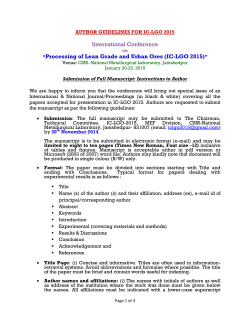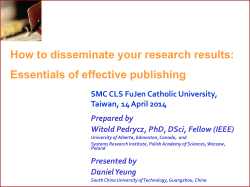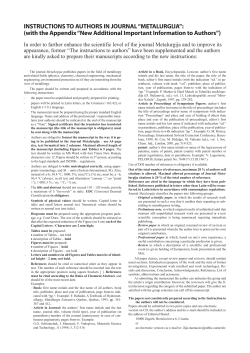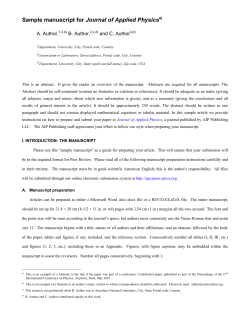
Instructions for Authors Romanian Biotechnological Letters
Instructions for Authors updatedaccording to the new regulations in the publication policy of Romanian Biotechnological Letters All papers submitted after January 1-2012, that were not already published, and do not include this information, should have their manuscript revised accordingly. The journal (ISSN 1224-5984) provides publication of papers on biotechnology, applied molecular biology, applied microbiology, biochemistry and related fields (Functional Genomics, Metabolic Engineering, Somatic Cell Genetics, Cell Biology, Developmental Biology, Micropropagation, Physiology, etc.). The Journal welcomes the submission of manuscripts that meet the general criteria of significance and scientific excellence, as original research papers, reviews and short communications, concerned with the latest developments and state –of –the-art research in the above-mentioned fields. The journal has six issues per year and the submitted papers will be published approximately three or four months after their final acceptance. Electronic submission of manuscripts should, provide that the text, tables, and figures are included in a single Microsoft Word file(of maximum 10 pages) in TimesNewRoman font, 12 pts, typed at one space between lines. Submit manuscripts as e-mail attachment to the Editorial Office at: romanianrbl@gmail.com. A manuscript number will be mailed to the corresponding author in the same day or within 72 hours. The cover letter should include the corresponding author's full address and telephone/fax numbers and should be in an e-mail message sent to the Editor, as an attachment. RBL will submit the manuscript to reviewers. Article Types Three types of manuscripts may be submitted: Regular articles: These should describe new and carefully confirmed findings, and experimental procedures should be given in sufficient detail for others to verify the work. The length of a full paper should be the minimum required to describe and interpret the work clearly, respectively of about 8 to 10 manuscript pages. Short Communications: A Short Communication is suitable for recording the results of complete small investigations or giving details of new models or hypotheses, innovative methods, techniques or apparatus. The style of main sectionsneed not conform to that of full-length papers. Short communications are 2 to 4 printed pages (about 6 to 8 manuscript pages) in length. Minireview: Submissions of mini-reviews and perspectives covering topics of current interest are welcome and encouraged. Mini-reviews should be concise and no longer than 4-6 printed pages (about 10 to 12 manuscript pages). Mini-reviews are also peer-reviewed. Review Process All manuscripts are reviewed by 3qualified foreign reviewers. Please suggest 2 qualified reviewers, the third reviewer will be designated by the Editorial Board and their comments are returned to authors. Decisions will be made as soon asthe authors operated all the corrections recommended by the reviewers, and send back to the Editor the final form of the manuscript. The editorial board will re-review manuscripts that are accepted pending revision and will inform authors with the number of the journal issue in which their work will be published. Regular articles Papers must be written in English, and authors are urged for clarity, brevity and accuracy of information and language. Authors whose first language is not English should have their papers checked for linguistic accuracy by an English language native or specialist. If the article is not written in proper English it will be automatically rejected. Submitted manuscripts should conform to the following format and sequence: All portions of the manuscript must be typed 1.0-spaced(single), all pages numbered starting from the title page and the elements comprising the manuscript must be ordered as follows:Title, Abstract, Key words, Introduction, Materials and Methods, Results and Discussions, Conclusions, Acknowledgements, References. Titles should not exceed 90 characters (including spaces). Titles should not include numbers, acronyms, abbreviations or punctuation. They should include sufficient detail for indexing purposes but be general enough for readers outside the field to appreciate what the paper is about.The Title Page should include the authors' full names and affiliations, the name of the corresponding author along with phone, fax and E-mail information. Present addresses of authors should appear as a footnote. The Abstract should be informative and completely self-explanatory, briefly present the topic, state the scope of the experiments, indicate significant data as methodology and results, and point out major findings and conclusions. The Abstract should contain a maximum 200 words but no less than 150. Complete sentences, active verbs, and the third person should be used, and the abstract should be written in the past tense. Standard nomenclature should be used and abbreviations should be avoided. No literature should be cited. About 3 to 10 key words, are to be provided directly below the abstract, that will be represented by terms not used in the title but significant for the performed research Scientific style Nomenclature: Authors should use systematic names similar to those used by Chemical Abstract Service or IUPAC. Names of chemical compounds follow the Chemical Abstracts (Chemical Abstract Service, Ohio State University, Columbus) and its indexes. Biochemical terminology, including abbreviations and symbols, follows the recommendations of the IUPAC−IUB Commission on Biochemical Nomenclature. Enzymes. The International Union of Biochemistry and Molecular Biology Enzyme Commission (EC) number and full name (Enzyme Nomenclature 1992, Academic Press, San Diego and London) must be quoted when first mentioned in text. Trivial names may be used in the title. Other Nomenclature: Racemates. Authors must state unambiguously in the Methods section of papers which isomers were used, e.g. (+)– or (–)–propanolol, and must bring to the attention of the reader the composite character of drugs that were mixtured of stereoizomers; Eicosanoids.The system of nomenclature to be used for eicosanoids is that published in Methods in Enzimology, 187, 1–9 (1990). Tension. Tension is force and should be calibrated in newtons (1 newton=1 Kg m s–1) or in kg weigh, g weigh, or mg weigh etc. Trends Pharmacol.Sci., 9, 124–125 (1988). Ions. When referring to ions, tile charge should be indicated, e.g. + Na , Ca2+, 2Na+/Ca2+ exchange, etc. Inhibitors of nitric oxide synthase. The most commonly used and currently accepted abbreviations for NG - nitro - L - arginine and NG - nitro - L - argininc methyl ester are L - NOARG and L - NAME respectively. Cell lines. Cell type, species and source should be defined. Genes and proteins symbol: The name of the gene must be written italic and the name of protein with capital letter. Eg: act2 (β-actine gene); GFP: green fluorescent protein Genes fusion and constructs: Promoter-coding sequence fusions and fusions of coding sequences must be written as: 35S:GFP, CRY2:GFP A double colon should be used only for insertions (such as insertions by transposable elements), as in An1::dTph1, Bz1::Ac, or LFY::TAG1. Lowercase "p" should be used to refer to plasmids (e.g., pBR322), and to avoid confusion it should not be used to refer to promoters. Accession numbers: Accession Numbers” for any genes or new sequence data discussed in the article. Abbreviation and Symbols An internationally accepted signs and symbols for units, SI units must be used. The Introduction should provide the background for the work, a brief overview of the relevant literature on the subject, and indicate the goals of the experimental work with the proposed approach or solution. It should be understandable to colleagues from a broad range of scientific disciplines. Materials and methods should be complete enough to allow experiments to be reproduced, providing names of organisms, a detailed description of procedures (growing media and conditions, equipment and equipment settings, chemicals, supplemental test organisms and statistical procedures). All protocols must be cited, however, only genuinely new procedures should be described in detail; previously published procedures should be cited, and important modifications of published procedures should be mentioned briefly. Capitalize trade names and include the manufacturer's name and address. Subheadings should be used. Methods in general use need not be described in detail. Long or running descriptions of treatment levels should be placed in a table. The doses of reactives should be given as unit weight per body weight, e.g.₠mmol kg 1 or mg kg 1; concentrations should be given in term of molarity, e.g. nM or µM. Results and Discussions should be presented with clarity and precision, following the experimental order initiated in the materials and methods, and should be written in the past tense when describing findings in the authors' experiments. . Results should be presented for each experiment as paragraphs, each paragraph having a topic sentence outlining the results to be discussed in that paragraph and a citation to a table or figure were the results are presented. The discussions should present the philosophy, reasoning and arguments of the results, which should not be repeated, but discussed in relation to other experimental work and the perceptions of the investigator, interpreting the findings in view of the results obtained in this and in past studies on this topic. Unexpected results should be explained. State the Conclusions in a few sentences at the end of the paper, in a separate chapter.The Acknowledgments (when necessary) should be typed as one separate paragraph that precedes the references section, mentioning the sources of research support References should be numbered consecutively and placed in a separate section at the end of the manuscript. In the text, references to other works should take the form (C. ONISCU & al. [4] or MARINESCU [5]. Reference to "unpublished obsevations" (works) or "personal communications" should be mentioned in the text only, and not included in the list of references. Papers in preparation or which have been submitted but not yet finally accepted, for publication must not be included in the of references. They should be typed single - spaced, with one line space between each reference. Each reference should contain names of all authors (with initials of their first and middle names); do not use et al. for a list of authors. Abbreviations of journal titles will follow the international standards. REFERENCES should be capitalized and centered above the reference list. A 10 pt characters must be used. Follow the acceptable reference formats: Journal: C. ONISCU, R. TUDOSE, D. CASCAVAL, Title of Article. Rev. Roum. Chim.,39(11),1343, 1350 (1994). Book: L.R. SNYDER, J.J. KIRKLAND, Introduction to Modern Liquid Chromatography, K.M. GOODING, F.E. REGNIER, eds., Marcel Dekker, inc., New York, 1990, pp. 301–332. Reference should be indicated in the text by an Arabic number in brackets. The full list of references should be numbered consecutively and be listed according to the order in which they are referred to in the manuscript text. References should be typed 1.0 - spaced, and Journal names are abbreviated according to Chemical Abstracts. Authors are fully responsible for the accuracy of the references. Tables and figures must be included in the text and complete with titles, units, and other information necessary to understand the table or figure without referring to the text. Material should be grouped so that the finished table or figure fits within an area of 4.3 x 7.2 inches ( all manuscripts that do not meet this requirement will be rejected) . Each table included in the text must be numbered consecutively with Arabic numerals. Number should be followed by a brief descriptive caption, not more than two lines, at the head of the table. Each column should have a heading and the unit of measurement (in parentheses in the heading). Tables should be self- explanatory and the absolute necessary descriptions should be at the bottom of the table.The same data should not be presented in both table and graph form or repeated in the text. FigurePlease note that unsatisfactory figures will be returned to the author for revision. The Journal rejects a manuscript if the figures are unacceptable. It is important that the printed symbols and lines should retain their clarity and each copy of the manuscript must be accompanied by one set of labeled figures (an original set and one high quality photocopy will suffice). The symbols used for plotting data points should be large enough to show up clearly when reduced to on - page size. Symbol should be chosen from the following set: Figure legends should be typed in numerical order in the text and each figure must have a legend below the figure. Graphics should be prepared using applications capable of generating high resolution GIF, TIFF, JPEG preferable TIFF or Power Point before pasting in the Microsoft Word manuscript file. Tables should be prepared in Microsoft Word. Use Arabic numerals to designate figures and upper case letters for their parts (Fig 1). Begin each legend with a title and include sufficient description so that the figure is understandable without reading the text of the manuscript. Information given in legends should not be repeated in the text. Photographs. These should be submitted, twice as large as their intended published size as good quality prints of high contrasts, especially where traces and records are illustrated. Footnotes.Authors are encouraged to minimize the use of footnotes. A footnote may include the designation of a corresponding authors of the manuscript, current address information for an author and traditional footnotes content. Footnotes should be indicated in the text by the following symbols: * (asterisk), + (dagger), ‡ (double dagger), j (paragraph mark), (section mark), || (parallels), # (number sign). Please do not use numerals for footnote call - outs, as they may be mistaken for bibliographical reference call - out or exponents. For the footnotes within a table the same symbols listed above are recommended. Short Communications Short Communications are limited to a maximum of two figures and one table. They should present a complete study that is more limited in scope than is found in full-length papers. The items of manuscript preparation listed above apply to Short Communications with the following differences: (1) Abstracts are limited to 100 words; (2) instead of a separate Materials and Methods section, experimental procedures may be incorporated into Figure Legends and Table footnotes; (3) Results and Discussion should be combined into a single section Copyright: Submission of a manuscript implies: that the work described has not been published before (except in the form of an abstract or as part of a published lecture, or thesis) that it is not under consideration for publication elsewhere; that if and when the manuscript is accepted for publication, the authors agree to automatic transfer of the copyright to the publisher. Fees and Charges: The publication charges of one article in Romanian Biotechnological Letters is of 50 Euro (VAT INCLUDED). Color figures will be extra charged at 20 Euro/figure. All fees are payable after the article is accepted for publication.
© Copyright 2025





















